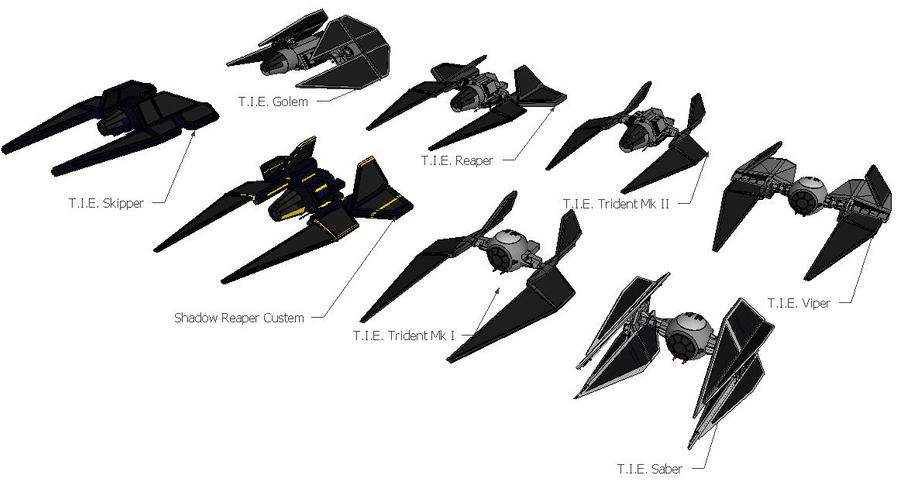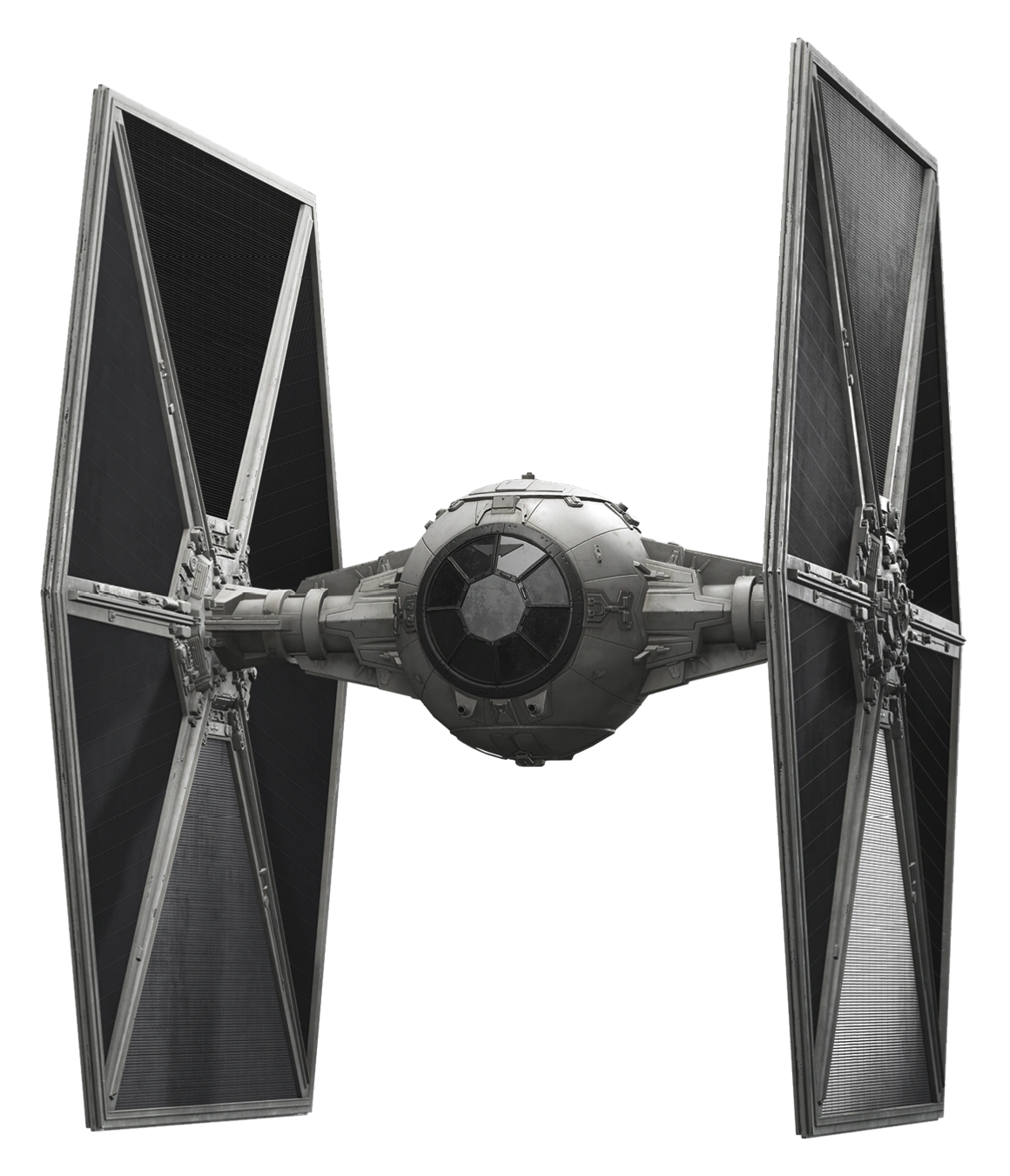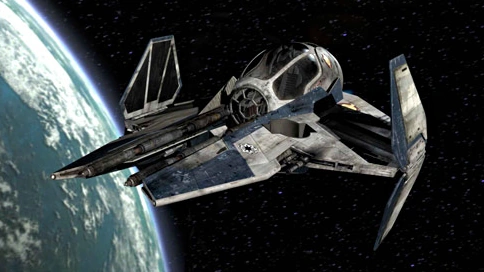Why not the Typhoon? It represents a knock-off of the iconic Tie-Fighter, though one tailored to the conceits of GURPS Spaceships. It's been central to all my previous dogfighting examples, and so definitely has a place here. But the Typhoon, as written, in GURPS Spaceships 4, has a few problems. For one thing, it has two fusion reactors when, at most, it needs only one. The second is that it’s heavily armored, which may work well for GURPS Spaceships, but will definitely not fly in our new system, where starfighters work like actual fighters, and tons of heavy armor would make it drop out of the sky!
So, we need to build a new Typhoon. The real intent of this design is not necessarily to give us a final version of the Empire’s primary starfighter, but to give us something we can play with when fixing the dogfighting system for Psi-Wars. It also gives me a chance to meditate upon the Typhoon and its inspirations from Star Wars and from the real world.
The TIE-Fighter
The TIE fighter is probably the second-most iconic starfighter in popular media, eclipsing all other starfighters but the X-wing. Nonetheless, I have some serious issues with the design, and I am not the only one. Generation Tech pretty handily captures the glaring flaws with them in this video. Let’s discuss what makes them work, and what I would change.The core premise of a TIE fighter is pretty good. It’s a cheap, bare-bones fighter that’s essentially engines with mounted cannons. This is why I chose it first: it’s probably the simplest fighter to design for Psi-Wars. It lacks hyperdrive, force screen and even life support (at least, according to the Complete Guide to Vehicles that I have). This is its strength, what makes it good.
Nonetheless, it has serious issues.
The first major issue are the solar
panels. They frankly make no sense and I think they exist primarily
to excuse their distinctive appearance in typical Star Wars fashion
of “cool design first, fancy explanation second.” I can
sort of see the reasoning behind them: solar panels remove the need
for any generator or battery or, if we’re talking reactionless
engine, fuel. They’re self-powering, which makes them very
cheap, which is supposedly the idea. In practice, they present an
enormous target, solar power isn’t nearly that efficient, and
I’d rather give my ships fuel-using plasma thrusters.
The second glaring issue is their cockpit design. If you look at modern fighters, they have a “bubble” canopy. This allows them to look in a full 360 degrees around them, and to look above. A TIE’s cockpit gives them tunnel vision (and even if it didn’t, those ridiculous wings would). An ideal design would be a fully armored cockpit with cameras and holographic internal display, or barring that, make the entire bubble transparent, but these would both ruin the aesthetic. Nonetheless, we’d want a much fuller field of view, if possible.
I don’t actually mind the lack of force screen, the lack of life-support or the evidently light armor. All of this says “disposable fighter” meant to attack in swarms, and speaks to the industrial might of the Empire. I do mind that their pilots are portrayed as the “best of the best,” because one clearly would not put his ace pilots in these things, as that would be suicide. I’m also not convinced that they’re making their fighters “as cheap as possible” so much as ruthlessly removing everything that isn’t strictly necessary. They clearly have decent electronics (they have the equivalent to radar tracking systems in their video games), and likely top-of-the-line designs, but they’re meant to be mass-produced and mass-piloted. These are not machines for the “best of the best.”
I have a few structural quibbles.
Frankly, they need landing gear. This notion that they launch from
racks is rigid, lacks resilience and just looks terrible. Their guns
are also unrealistic. If you dig into the Visual Guide on Star Wars
vehicles, you’ll find that their guns are about as long as your
arm, yet are depicted as as dangerous as the guns on an X-wing, which
are great spears longer than a person. Size-wise, as far as GURPS is
concerned, the latter is far more likely.
So, to me, a "better" TIE-fighter would simply have a generator, have wings that helped it fly (possibly nonsense in Star Wars, but sensible in a hyperdynamic universe like Psi-Wars), a cockpit that gave a wider view, and would be deliberately used as a mook ship. The empire has endless resources, both in the forms of materiel and personnel. They can afford to mass-produce both fighters and pilots and send them at their enemies in waves. I would definitely retain the purity of form: all speed and firepower and agility and nothing else.
The Typhoon Inspirations
This article by Popular Science argues that the Messerschmitt Bf 109 inspired the TIE fighter. This fighter was mass-produced and while clearly inferior to their British counterparts, nonetheless had a certain amount of “German engineering excellence” and relied on mass production to beat out their British rivals which, of course, they failed to do.Personally, though, I see the Japanese Zero as a more worthy inspiration for the Typhoon. Like the TIE-Fighter, it’s a fighter stripped down to its essentials. I also see the Typhoon as something of an elegant ship. Yes, it’s mass produced, and yes, it’s inferior to its more robust opponents, but it has an elegance that one can appreciate if handled correctly. Put a Typhoon in the hands of an average pilot and give him 20 allies, and it’ll do fine, but put it in the hands of a master and it might surprise you. It’ll never be the best fighter, but it might earn some admiration.
They suggest various MiG aircraft as a more modern equivalent and that’s fair. They’re a good “bad guy” craft, and MiGs have been quite competitive with western aircraft for a long time, as well as presenting some decent technological challenges. They’re also very widely produced, the sort of fighter one might meet in droves. Personally, I see this sort of “second-stringer” fighter reserved for other factions in the setting, but the Typhoon should, by no means, by the “best of the best.” For a modern fighter, I think I would compare it to the Su-35, which probably holds the title for “good try” when it comes to a 5th generation fighter, with greater emphasis on dogfighting capability and being cheaper than its rivals, while still having a solid electronic suite and remaining competitive with the best that its enemies have to offer (the F-35).
For fictional counterparts, I’m a fan of the Wing Commander universe, and I would compare it to the Hornet: a technologically competent ship that’s high on speed and maneuverability, but light on firepower. That said, I’m quite taken with the Kilrathi “Dralthi” design with its forward swept wings: yes, this presents a large target and cuts down on the pilot’s visibility, but not nearly as badly as the TIE-fighter design does, while still retaining that menacing aesthetic. The Sith fighter from Star Wars legends has a similar sort of profile, and actually addresses quite a few complaints I have about the TIE fighter.
If we look back at Star Wars itself, and the various complaints leveled against it, an even better contender emerges in the form of the Eta-2 Actis-class interceptor. It’s cockpit resembles the TIE-fighter, except it provides far more lateral visibility, thanks to the more generous canopy, and the lower wing profile. Like the TIE-fighter, it’s a bare-bones craft, with basically nothing more than the requisite engines, cockpit and cannons. Those cannons are also more likely to be “GURPS accurate,” as they’re far larger than the “heavy blaster” look of the original TIE-fighter, more like smaller tank cannons, which is closer to what we might expect. Its wings even look as though they might carry hardpoints, allowing for missile fire.
The Typhoon 2.0 Mission Profile
A ship should ultimately be designed around its mission. How does the Empire intend to use their vehicle? And how does it fit their military doctrine?
The Empire is a professional army “of
the people.” In contrast to the aristocratic Alliance, they
rely not on elite, trained-for-birth aristocratic warriors, but on
professionally trained every-men. They also count on speed of attack
and sheer numbers. They want to shock-and-awe their opponents into
submission with a blitzkrieg attack that completely overwhelms their
opponent. They prefer to do this with giant dreadnoughts, when it
comes to space battles, but they can also do it with a great cloud of
fighters!
These fighters would need to be easy
enough of that a pilot could be quickly trained to pilot one. They
are not the “best of the best,” but the space-equivalent
of a soldier put through boot camp, handed a rifle and pointed at
the enemy. They survive through strength of numbers and the
superiority of their weapons, such as they are. These fighters also
need to be light enough, small enough, that many can be mounted in
the strange, dual-purpose “battlecarrier” dreadnoughts.
Finally, they need to balance quality with quantity, with their
quality focused on “defeating the enemy” rather than
“keeping the pilot alive.” thus, they should focus on
firepower, numbers and speed over survivability.
The Typhoon itself would be perform
several missions. Its primary purpose would be space superiority
fighter: It is meant to deploy from a dreadnought and clear space of
any enemy fighters to keep the dreadnought alive and allow any
heavier vehicles, like bombers, to perform their mission. They also
need to be able to engage in interception. The Empire will often
need to defend or interdict worlds, and a single dreadnought cannot
be everywhere, but its fighters greatly extend its reach. Thus, if
the dreadnought detects an enemy, it must be able to scramble its
fighters quickly, and send them off on missions thousands of miles
away in very short order. Finally, the fighter would probably engage
in “beyond the horizon reconnaissance” using its speed to
check out spots that the dreadnought cannot quickly reach, and a wing
of them might act as an escort, either for prestige or legitimate
protection.
All of this suggests a fast, well-armed
ship with a fairly modest amount of fuel. It will rarely need to
spend days away from its carrier, likely hours at most. It is a
tightly bound ship, more like a “carrier” fighter than a
“ground-based” fighter.




No comments:
Post a Comment
Note: Only a member of this blog may post a comment.